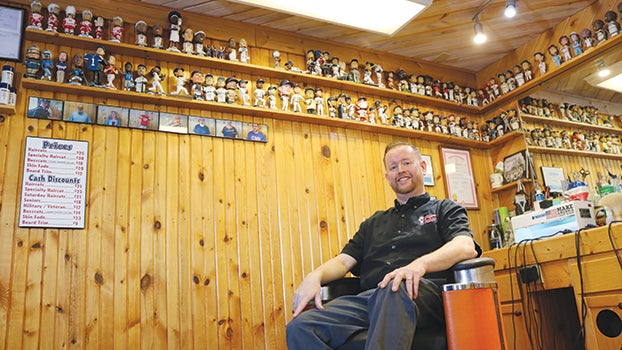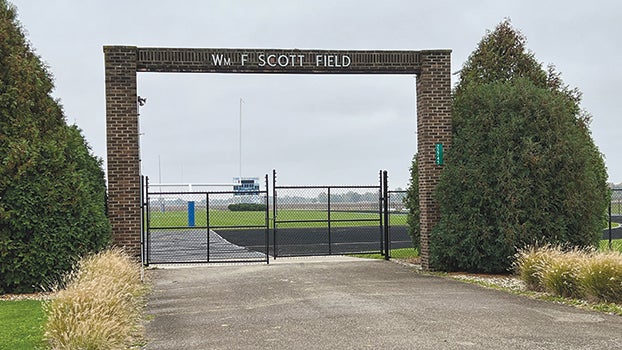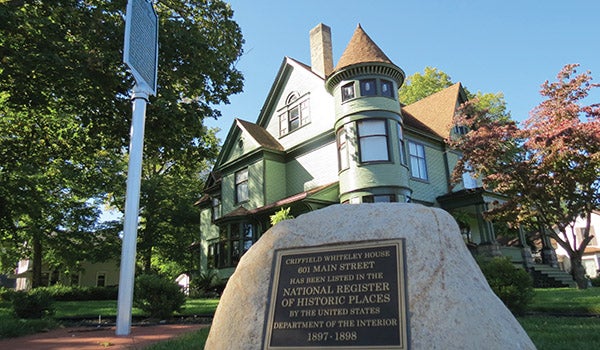HORIZONS 2015: A thousand years of history
Published 11:12 am Thursday, February 26, 2015
The Dowagiac area means a lot of things to a lot of different people.
For students attending classes at Southwestern Michigan College, it’s a place to learn, to chart the course they will follow for the rest of their professional lives.
For the business owners of the stores and restaurants lining the streets of downtown, it’s a place where people make a living, with more than 200 years of history at their backs.
For the people of Pokagon Band, it’s the land they’ve called home for a millennium.
From the mascot of the Dowagiac Union Schools’ athletic teams to the name of the city itself, this subset of the Potawatomi Indian nation’s influence on the region is undeniable. The band remains at the heart of the community, whether through donations to local schools with funds from the Four Winds chain of casinos or with cultural celebrations such as their Kee-Boon-Mein-Kaa Pow Wow, held during Labor Day weekend on Rodgers Lake.
Like many Native American tribes, though, the path to prosperity was fraught with hardships. Despite fending off attempts at relocation, the Pokagon Band spent many years overcoming their own set of trials, from reuniting its people both physically and culturally, to a protracted fight with the U.S. government for recognition and sovereignty.
The beginning
The origins of the band are tied with the rest of the Potawatomi nation, which, at its peak, stretched from lands in what is present-day Green Bay, Chicago and Detroit. Though most stories say that the tribe lived in these lands for at least 1,000 years, many differ in their accounts in how they actually arrived there.
“We have a lot of different stories, which depend on which region you came from,” said Marcus Winchester, the historic preservation officer with the Pokagon Band. “I’ve heard stories around here that we’ve always been here. If you ask other Potawatomi, they’ll tell you that we migrated here along with the Ojibwe and Odawa from the East Coast along the St. Lawrence River. That’s probably the most generally accepted [account].”
The Potawatomi, Ojibwe and Odawa nations were joined together in a loose alliance known as the Three Fires Confederacy. Once united as a single tribe, each nation split off into their own sovereign nation, but continued to serve a specific function to the other members of the confederacy: the Ojibwe were known as the “Keepers of Tradition,” the Odawa as the “Keepers of Trade” and the Potawatomi as the “Keepers of the Fire.”
“When we pray, we put tobacco into a fire, and the smoke goes up,” Winchester said. “Our prayers go up to the Creator, we believe, so the fire helps with that. The Keepers of the Fire is a real spiritually important role amongst our people. We take that very seriously, that name.”
The greater Potawatomi tribe was a similar loose conglomeration, with leaders only assembling in rare occasions to deal with matters that affected the entire tribe, Winchester said. For the most part, the people assembled into autonomous villages, which came together during the summer months before each family went their separate ways during the winter.
“To be the leader of a village, all you had to do was be influential,” Winchester said. “You had to catch people’s ears and get some followers. If you had you and your family, and two other families join you, you had a village. It could be as little as that, or as many as a couple thousand. The more influential leaders were able to get that many.”
Settlers of the southern Michigan area generally lived similar lifestyles. While popular culture portrays most Native Americans as hunter-gatherers, the truth is that most villages thrived off crops generated through farming, supplementing the game, fish and berries harvested from the forests and rivers spanning the area.
Ironically, the lands that host the Pokagon Tribal offices today were once unsettled, with its abundance of natural resources used in another manner. The name “Dowagiac” is derived from the Potawatomi tongue, roughly translated to “where to go fish” or “where to gather/harvest.”
“We didn’t have too many villages up this way,” Winchester said. “This is where we would come to pick or gather.”
The Potawatomi’s first contact with the Europeans wouldn’t occur until the 17th Century, when French explorers from the Quebec area encountered people of the “nation of fire,” around the Green Bay area. The members living in southwest Michigan met the French during the 1860s, when Claude Jean Allouez established Fort St. Joseph in the Niles area.
While the language and cultural barriers naturally created some conflict between the natives and the explorers, both sides would benefit from the exchange of ideas and goods resulting from fur trading that would flourish for the next several decades.
“They were constantly creating and recreating this social space they had created around the fur trade,” Winchester said. “They were constantly negotiating with each other on how to interact. But they were more or less able to meet on the middle ground.”
One of the customs that the French adopted during their deals with the Potawatomi was that of gift giving, which was a central tenet of hospitality within the tribe, Winchester said. As a result, guns, fabrics and other products of European design were introduced to the people living in the area, given to them as a sign of goodwill by the visitors.
This tradition would set the stage for Pontiac’s Rebellion in 1763, where the Potawatomi and their allies with the Three Fires Confederacy would join with other Great Lakes tribes to expel colonists from Great Britain, who had usurped the French as the main European power in the region following their victory in the French and Indian War earlier that year. British traders refused to honor the customs established in years of trade with the other European power, sparking the three year conflict.
Becoming America
Following the end of hostilities, the British adopted a model based off the Franco-Native trade, leading to an era of relative peace between the two nations. This relationship continued even following the American Revolution and the creation of the United States.
“In the War of 1812, some Potawatomi fought with the British, and some fought with the Americans,” Winchester said. “But they never ever fought each other. If they went on the battlefield and they saw there were Potawatomi on the other side, they would back away from the fight.”
It was during this period of interaction with the expanding American nation that the Pokagon Band saw its genesis. In 1795, in Greenville, Ohio, Potawatomi leaders were among those of several other tribes who signed what would become the first of several treaties with the U.S. government. In exchange for portions of their land, the tribes received yearly grants of federal money and fabric, establishing what would later be known as the annuity system.
Fighting for rights
The U.S. followed a policy then of “civilizing” Native Americans living in these lands, teaching them European farming techniques, converting them to Christianity, and other methods of assimilating them to their culture. However, this policy of integration fell through following the recommendations of missionary Isaac McCoy, who believed that relocating the tribes out west to establish their own state would improve this process.
This led to the Indian Removal Act of 1830 and the Treaty of Chicago in 1833, which paved the way for the relocation, often at gunpoint, of the Potawatomi from the lands they called home for generations. The trip west killed nearly one in 10 of the 500 people forced from their homes, causing it to be known as the Potawatomi Trail of Death.
A small village of Potawatomi living in what is now Bertrand Township in Niles, though, managed to retain their lands thanks to ingenuity and dedication of their leader, Leopold Pokagon. Pokagon was among several tribal leaders who convinced the Catholic clergy located in the Detroit area to establish a mission near their village, to show their commitment to integration.
“At first, they weren’t going to do it,” Winchester said. “Because of our long history with the French in the area, and because we had a Catholic presence here throughout the 1700s, some of those older prayers had been passed down and converted from English into Potawatomi. The story goes that Leopold had started reciting one of those prayers in the old language, which blew the guy away in Detroit.”
Contrary to the reports that McCoy would send to Washington about other Potawatomi tribes, the villagers in Pokagon’s care quickly developed a deep faith in Catholicism.
“The Potawatomi were picking and choosing what worked and fit for them” Winchester said. “They weren’t accepting all English customs and abandoning all Potawatomi ways.”
In 1836, Pokagon successfully petitioned to have his people remain in the Great Lakes area, though they still had to relinquish their present lands. The leader relocated his followers to Silver Creek, using funds given to them from previous treaties to purchase the land.
Despite that, local Michigan leaders attempted to force the population from their land shortly thereafter, once again forcing the aging Pokagon to travel East to secure the safety of his village. He was able to secure a written judgment from Michigan Supreme Court Justice Epaphroditus Ransom, who ruled that the treaty signed earlier allowed them to stand their ground.
“When the militia shows up at Pokagon’s village to remove everybody, Pokagon gives them that letter,” Winchester said. “They never bothered them again.”
The strong leadership provided by Pokagon would eventually fade, though, following his death in 1841. Without anyone able to unite the village like he was able to, many of Pokagon’s charges began to spread out, settling in lands around Bush Creek and Rush Lake.
Despite the physical separation, the Pokagon Potawatomi continued to remain united, keeping in contact throughout the next two centuries. They waged legal wars with the U.S. government during the late 1800s to secure annuities that were still owed to them, Winchester said.
“It wasn’t just about the money, it was about our leaders making sure the government knew we were still here, and they still had their obligations to us,” Winchester said. “We were still a nation, and we weren’t going to let them forget about us.”
A future of freedom
By the turn of the century, though, this sense of unity had begun to wane, as many Pokagon members began to move closer to major cities, with the new generation forgoing practicing ancestral cultural traditions altogether, Winchester said.
The government passed the historic Indian Reorganization Act of 1934, which provided tribes across the U.S. with resources to establish tribal governments. The Pokagon Band was dealt an additional blow following the passage of the law, though, as the Bureau of Indian Affairs lacked sufficient funding to help the tribe establish its own sovereignty, with the Saginaw Chippewa Indian Tribe being the only one from the lower peninsula of Michigan to receive federal recognition.
In the spirit of the man they were named for, this challenge spurred members of the tribe to overcome this obstacle.
For the next 60 years, a number of Pokagon citizens and volunteers would fight for federal recognition and the sovereignty that came with it. Beginning shortly after the passage of Indian Reorganization Act all the way up to the early 1990s, the Pokagon Tribal Council waged a war with the Washington bureaucracy in their struggle to gain the rights and privileges given to federally recognized tribes.
“The goal was to be able to take care of our people, and to take care of them in a way that satisfied health issues, educational issues, assistance issues,” said Bob Moody, vice chairman of the Pokagon Band Tribal Council. “We really wanted our people to live at a standard that was the same as everybody else.”
Moody first joined the fight for recognition as part of the tribal council during the early ‘80s, he said. Thirty years earlier his grandfather had fought the same battle, also serving on the council.
For years, the tribal leaders argued their case for recognition to the Bureau of Indian Affairs, though they were met with stringent requirements for establishing proof of their tribe’s history and ongoing governance, Moody said. Leaders spent countless hours pouring through old records and files to prove their claims, only to br rebuffed by additional requirements.
“Washington wanted a lot of information, at the time, (that) we couldn’t really lay our hands on,” Moody said. “That didn’t mean that information wasn’t there, we just had to dig for it. When we did find it, and thought we could sit back and breathe a little bit, we’d get 10 more questions back.”
A dream realized
After decades of attempting to argue their claim with the bureau, the tribal council decided to take another approach, enlisting the help of U.S. Representatives Fred Upton and Tim Roemer to create a peace legislation in Congress that would recognize the Pokagon Band as a sovereign tribe. On Sept. 21, 1994, the combined efforts of the tribe and the legislators finally paid off when President Bill Clinton personally signed the bill establishing the Pokagon Band of Potawatomi as a federally recognized Native American nation.
“It was an occasion of great joy, but also an awful lot of emotion as well,” Moody said as he recalled his feelings at the time. “It was like maybe a week later when I felt that a big mountain had been moved off my shoulders. It took about that long for it to really sink in.”
Twenty years later, the Pokagon Band is stronger than ever. Headquartered on Sink Road in Dowagiac, the tribe continues to grow. In addition to its three casinos, the Pokagon Band operates its own economic development corporation, Mno-Bmadsen, which currently owns three businesses across southwest Michigan. In December, the tribe opened up its new $13 million health and wellness facility, located on the Rodgers Lake Campus.
“This is where our homelands are,” Moody said. “We work here, we play here, we live here. We’re a part of that community, and we want to add to that community in what ways we can.”
The one success that Winchester finds the most encouraging is the revival of the traditions that his people celebrated on these lands, 1,000 years ago.
“My generation, and my parents’ generation, were extremely pivotal in bringing back the culture, and instilling it back in our lives,” Winchester said. “Thanks to our parents, this is all we know.”







